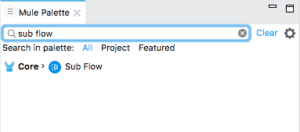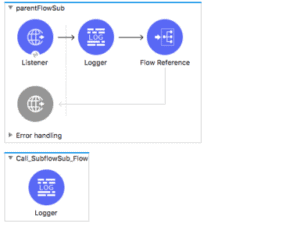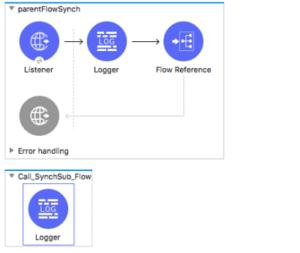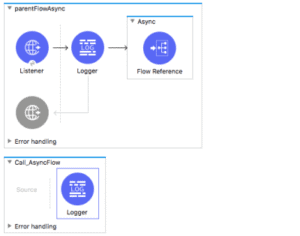1. 简介
Mule 是一个基于 Java 的企业服务总线(ESB)解决方案,广泛用于构建集成系统。我们通常使用 Anypoint Studio(一个 Eclipse 插件)来开发 Mule 应用。
本文将先简要介绍 ESB 和 Flow 的概念,然后重点讲解 Mule 中几种不同类型的 Flow 及其适用场景。✅ 掌握这些 Flow 类型的区别,能避免不少“踩坑”。
2. 企业服务总线(ESB)
ESB 是连接多个独立应用系统的中介层,这些系统可能使用不同的协议或数据格式。ESB 负责消息的转换、路由和协议适配,从而实现服务之间的解耦——每个服务无需关心其他服务如何消费它的输出。
在 Mule 中,组件(Component)是构建应用的基本单元,负责数据的处理和流转。我们通过 Anypoint Studio 右侧的 Mule Palette 添加组件:
多个组件可以组合成一个 Flow。一个 Mule 应用通常由一个或多个 Flow 构成。
3. 什么是 Flow?
Flow 是一组连接在一起的 Mule 组件,用于处理消息的完整生命周期。
一个典型的 Flow 包含:
- 入站接口(Inbound Endpoint):消息的入口
- 出站接口(Outbound Endpoint):消息的出口
- 中间处理逻辑(如转换、过滤、调用外部服务等)
每个 Flow 可以配置:
- ✅ 处理策略(Processing Strategy):决定消息如何被处理(同步/异步)
- ✅ 异常处理策略(Exception Strategy):定义出错时的行为
- ✅ Flow Reference 组件:用于调用其他 Flow 或 Subflow
Mule 中有三种主要的 Flow 类型:
| 类型 | 调用方式 | 是否继承父 Flow 策略 | 执行模式 |
|---|---|---|---|
| Subflow | Flow Reference | ✅ 继承 | 同步 |
| Synchronous Flow | Flow Reference | ❌ 不继承 | 同步 |
| Asynchronous Flow | Flow Reference + Async Scope | ❌ 不继承 | 异步 |
4. Subflow
Subflow 用于封装可复用的公共逻辑,比如日志记录、数据校验等。
特点:
- ✅ 同步执行:调用方 Flow 会阻塞,直到 Subflow 完成
- ✅ 继承父 Flow 的处理和异常策略
- ✅ 可被多个 Flow 复用
使用方式:
- 从 Mule Palette 拖拽 Subflow 组件:
- 在主 Flow 中使用 Flow Reference 调用:
⚠️ 注意:如果你不希望继承父 Flow 的异常处理逻辑,就不要用 Subflow,改用 Synchronous Flow。
5. Synchronous Flow
Synchronous Flow 也是一种同步执行的 Flow,但它不继承调用方的处理和异常策略。
特点:
- ✅ 同步执行:调用后必须等待完成
- ❌ 不继承父 Flow 的策略,有独立的配置
- ✅ 适合事务性操作(单线程执行,保证上下文一致)
创建方式:
直接添加一个普通 Flow 即可(Mule 中没有单独的“Synchronous Flow”类型,普通 Flow 默认就是同步的):
调用方式:
使用 Flow Reference 组件调用:
✅ 使用场景:需要独立异常处理的同步任务,比如调用第三方支付接口并处理结果。
6. Asynchronous Flow
Asynchronous Flow 是异步执行的,调用后立即返回,不阻塞主流程。
特点:
- ✅ 异步执行:主 Flow 不会等待
- ❌ 不继承父 Flow 的策略
- ✅ 多线程执行,适合耗时操作
- ✅ 提升系统吞吐量
实现方式:
将 Flow Reference 组件包裹在 Async Scope 中:
适用场景:
- 发送邮件、短信通知
- 记录审计日志
- 调用非关键外部服务
⚠️ 注意:异步 Flow 中抛出的异常不会影响主流程,需单独配置异常处理。
7. 总结
| 类型 | 是否同步 | 是否继承策略 | 适用场景 |
|---|---|---|---|
| Subflow | ✅ | ✅ | 公共逻辑复用,需继承上下文 |
| Synchronous Flow | ✅ | ❌ | 事务性操作,需独立控制 |
| Asynchronous Flow | ❌ | ❌ | 耗时任务,提升性能 |
简单粗暴记法:
- 想复用 + 继承策略 → 用 Subflow
- 要同步 + 独立控制 → 用 Synchronous Flow
- 要异步 + 提高性能 → 用 Async Scope + Flow Reference
掌握这三种 Flow 的区别,能让你在设计 Mule 集成方案时少走弯路。更多细节可参考 Mule 官方文档。





